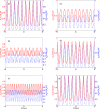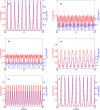Tunneling-induced Talbot effect
- PMID: 33767249
- PMCID: PMC7994822
- DOI: 10.1038/s41598-021-86289-w
Tunneling-induced Talbot effect
Abstract
We investigate the reforming of a plane wave into a periodic waveform in its propagation through a structural asymmetry four-level quantum dot molecule (QDM) system that is induced by an inter-dot tunneling process and present the resulting tunneling-induced Talbot effect. The tunneling process between two neighborhood dots is provided with the aid of a gate voltage. Using a periodic coupling field the response of the medium to the propagating plane probe beam becomes periodic. The needed periodic coupling field is generated with the interference of two coherent plane waves having a small angle and propagating almost parallel to the probe beam direction. In the presence of the tunneling effect of an electron between two adjacent QDs, for the probe beam propagating through the QDM system, the medium becomes transparent where the coupling fields interfere constructively. As a result, the spatial periodicity of the coupling field modulates the passing plane probe beam. We determine the minimum length of the QDM system to generate a periodic intensity profile with a visibility value equal to 1 for the probe field at the exit plane of the medium. It is also shown that by increasing the propagation length of the probe beam through the QDM medium, the profile of the maximum intensity areas becomes sharper. This feature is quantified by considering a sharpness factor for the intensity profile of the probe beam at the transverse plane. Finally, we investigate free space propagation of the induced periodic field and present the Talbot images of the tunneling-induced periodic patterns at different propagation distances for different values of the QDM medium lengths. The presented dynamically designing method of the periodic coherent intensity patterns might find applications in science and technology. For instance, in optical lithography, the need to use micro/nanofabricated physical transmission diffraction gratings, in which preparation of them is expensive and time-consuming, can be eliminated.
Conflict of interest statement
The authors declare no competing interests.
Figures












Similar articles
-
Voltage-controlled two-dimensional Fresnel diffraction pattern in quantum dot molecules.Sci Rep. 2024 Mar 9;14(1):5815. doi: 10.1038/s41598-024-55204-4. Sci Rep. 2024. PMID: 38461176 Free PMC article.
-
Two-dimensional linear and nonlinear Talbot effect from rogue waves.Phys Rev E Stat Nonlin Soft Matter Phys. 2015 Mar;91(3):032916. doi: 10.1103/PhysRevE.91.032916. Epub 2015 Mar 20. Phys Rev E Stat Nonlin Soft Matter Phys. 2015. PMID: 25871181
-
Theoretical study on the diffraction-based generation of a 2D orthogonal lattice of optical beams: physical bases and application for a vortex beam multiplication.J Opt Soc Am A Opt Image Sci Vis. 2022 Sep 1;39(9):1694-1711. doi: 10.1364/JOSAA.459929. J Opt Soc Am A Opt Image Sci Vis. 2022. PMID: 36215638
-
Veiled Talbot Effect.Phys Rev Lett. 2020 Dec 11;125(24):243901. doi: 10.1103/PhysRevLett.125.243901. Phys Rev Lett. 2020. PMID: 33412050
-
Perturbed Talbot patterns for the measurement of low particle concentrations in fluids.Appl Opt. 2012 Apr 1;51(10):1605-15. doi: 10.1364/AO.51.001605. Appl Opt. 2012. PMID: 22505081
Cited by
-
Voltage-controlled two-dimensional Fresnel diffraction pattern in quantum dot molecules.Sci Rep. 2024 Mar 9;14(1):5815. doi: 10.1038/s41598-024-55204-4. Sci Rep. 2024. PMID: 38461176 Free PMC article.
References
-
- Rayleigh L. On copying diffraction-gratings, and on some phenomena connected therewith. Philos. Mag. 1881;11:196–205. doi: 10.1080/14786448108626995. - DOI
-
- Talbot HF. Facts relating to optical science No. IV. Philos. Mag. 1836;9:401–407.
-
- Patorski K. The self-imaging phenomenon and its applications. Prog. Opt. 1989;27:1–108. doi: 10.1016/S0079-6638(08)70084-2. - DOI
Grants and funding
LinkOut - more resources
Full Text Sources
Other Literature Sources
Research Materials

